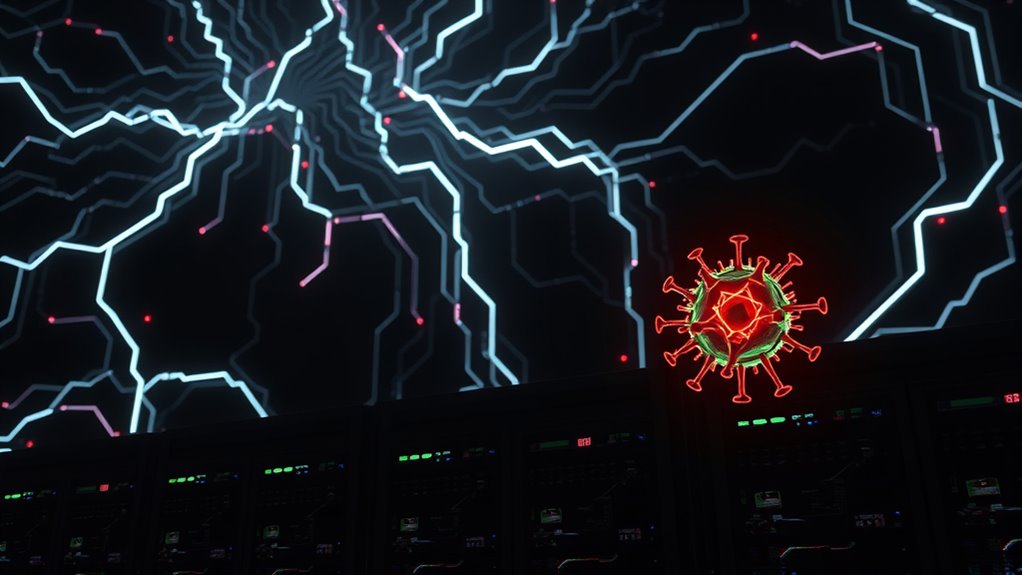Upgraded WormGPT variants have given cybercriminals powerful tools to launch more aggressive, personalized, and harder-to-detect AI-driven attacks. These models can automate scams, craft convincing phishing messages, and distribute malware at scale, making defenses more challenging. The ease of access lowers the skill needed to carry out such attacks, increasing their frequency and severity. If you keep exploring, you’ll understand how experts are working to counteract these evolving threats and protect your digital space.
Key Takeaways
- Upgraded WormGPT variants automate targeted phishing, scams, and malware campaigns, increasing their scale and sophistication.
- Customizable AI models enable highly specific and convincing malicious content tailored to attack goals.
- Enhanced models bypass traditional detection, making malicious messages harder to identify and filter.
- The proliferation of advanced WormGPT increases the frequency and severity of AI-driven cyberattacks.
- Collaboration between security experts and policymakers is essential to develop effective defenses against these evolving threats.

As artificial intelligence continues to evolve, malicious actors are developing increasingly sophisticated cyber threats, including WormGPT variants designed to automate and amplify attacks. These new versions of WormGPT pose serious risks because they can generate convincing malicious content at scale, making it easier for cybercriminals to target individuals and organizations. However, this advancement also raises significant ethical concerns. Developers and security professionals must ask whether creating or deploying such powerful tools is responsible. If these AI models are misused, they can facilitate scams, phishing, malware distribution, and other malicious activities. This creates a dilemma: how do we balance innovation with safety? Many worry that the widespread availability of WormGPT variants could lower the barrier for cybercriminals, enabling less skilled actors to launch complex attacks. This fear is compounded by the fact that these models can be customized to suit specific malicious goals, making them incredibly versatile and dangerous.
Detection challenges form another pivotal hurdle in combating WormGPT variants. Traditional cybersecurity measures rely on recognizing known threats or suspicious behaviors. But when malicious AI like WormGPT is involved, those methods often fall short. These models can craft highly personalized and convincing messages that bypass spam filters and human scrutiny alike. As a result, security teams struggle to detect such threats before they cause damage. The sophisticated language generated by WormGPT variants can mimic legitimate communications, making it difficult to distinguish a genuine email from a malicious one. This means organizations need to develop advanced detection techniques that can analyze AI-generated content for signs of malicious intent. But even with cutting-edge tools, staying ahead remains a challenge because malicious actors continuously adapt their tactics. Moreover, understanding the underlying technology of these models is essential for developing effective defenses.
The ethical concerns surrounding WormGPT are intertwined with detection challenges. As developers create more advanced models, they must consider the implications of distributing AI that can be used maliciously. It’s a delicate balance: restricting access might hinder beneficial research and innovation, while unrestricted access could facilitate widespread abuse. At the same time, security professionals need to innovate faster than cybercriminals to identify and neutralize threats. The evolving landscape demands a collaborative effort between AI developers, cybersecurity experts, and policymakers to establish safety standards and detection protocols. Without proactive measures, the threat posed by these upgraded WormGPT variants will only grow more severe, making it essential for everyone involved to stay vigilant and responsible.
Frequently Asked Questions
Can Wormgpt Be Used for Legitimate Cybersecurity Research?
You can use WormGPT for legitimate cybersecurity research, but it comes with ethical dilemmas. If you carefully navigate these challenges, it offers valuable research opportunities to identify vulnerabilities and improve defenses. However, you must guarantee responsible use, avoiding malicious intent. By doing so, you help advance cybersecurity efforts while mitigating risks associated with powerful AI tools, ultimately strengthening defenses against evolving cyber threats.
What Measures Can Organizations Take to Defend Against These Variants?
You should implement robust cybersecurity protocols, including regular updates and multi-layered defenses, to protect against these AI variants. Conduct thorough employee training to recognize and respond to suspicious activities, phishing attempts, and social engineering tactics. Staying vigilant and proactive helps prevent breaches. Additionally, monitor network activity continuously and establish incident response plans to quickly address any threats, ensuring your organization stays resilient against evolving AI-driven cyberattacks.
Are There Any Legal Restrictions on Developing or Using Wormgpt?
You should know that developing or using WormGPT faces legal constraints and ethical considerations. Laws vary by country, but many restrict creating or deploying malicious AI tools, especially those used for cyberattacks. Engaging in such activities can lead to serious legal penalties. Always consider the ethical implications, prioritize responsible AI use, and stay informed about regulations to guarantee your actions align with legal standards and moral responsibilities.
How Quickly Are These Wormgpt Variants Evolving?
The rate of evolution for wormgpt variants is astonishing—you could see significant improvements within just weeks. Their adaptation speed allows them to bypass new security measures rapidly, making them highly dangerous. This rapid evolution means you need to stay vigilant, as these AI-driven cyberattacks can adjust and refine their tactics faster than traditional threats. If you’re not prepared, you risk falling behind as these variants continue to evolve swiftly.
What Signs Indicate an Organization Is Targeted by Wormgpt-Based Attacks?
You’ll notice signs like behavioral anomalies and suspicious activities that suggest your organization is targeted by WormGPT-based attacks. These may include unusual network traffic, unexpected system crashes, or unknown files appearing. Keep an eye on irregular login patterns and data access, as WormGPT variants often exploit vulnerabilities silently. Early detection of these signs helps you respond quickly and prevent significant damage from these sophisticated AI-driven cyber threats.
Conclusion
With over 60% of organizations reporting increased cyber threats, these upgraded WormGPT variants pose a real danger. You now face more sophisticated AI-driven attacks that can craft convincing phishing emails or exploit vulnerabilities faster than ever. Staying ahead means understanding these risks and strengthening your defenses. Ignoring the threat isn’t an option—because as AI evolves, so do the cybercriminals. Be prepared, or you might become their next target.











